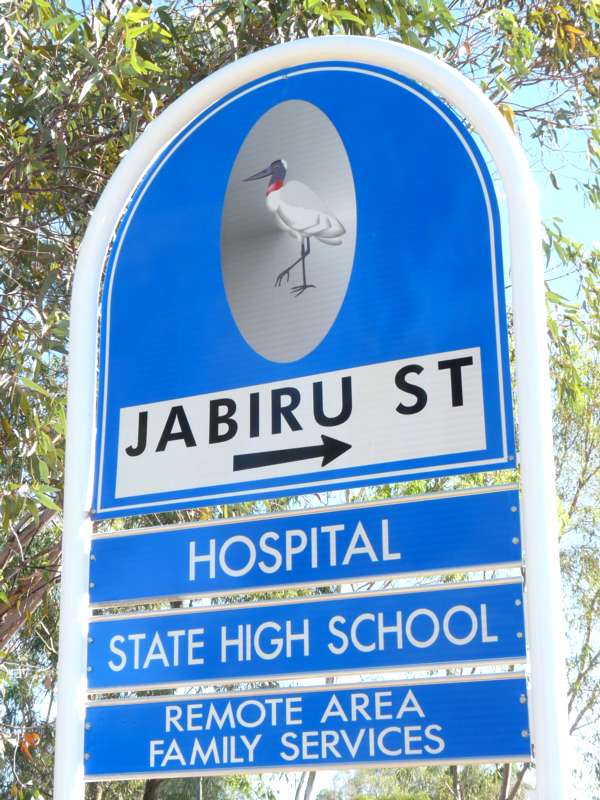I won't weigh into this one again. (Other than to disagree with the
proposal that we 'do (not)/should (not)' follow any dicta with regard
to it. There are no accepted rules and our responsibility is simply to
use whatever form we believe communicates most clearly, and to be
consistent.)
I am rather responding to Mark's comments about Jabirus. I recently saw
this rather fine street sign in Longreach, central Qld. Nearly all
other street names in town are of birds, all Australian; many people do
still refer to our only stork as 'Jabiru', and I'm sure the local
council intends this street to be named for it. Unfortunately the pic
is of what Mark would call the 'real' Jabiru, from the Amazon basin. A
salutory lesson not to rely too heavily on the first answer you get
from Google...
cheers all
Ian

Mark Clayton wrote:
Which, when it is all boiled down, shows we should be using scientific
names. However I dread to think how many spelling mistakes we would get in
something like Ephippiorhynchus asiaticus (Black-necked Stork for those who
don't know the name) - it would also get away from the misnomer of Jabiru!
Mark
-----Original Message-----
From: Philip Veerman [m("pcug.org.au","pveerman");">]
Sent: Tuesday, 15 June 2010 5:26 PM
To: 'Geoffrey Dabb'; 'Canberra Birds'
Subject: Great Crested Grebe and bird names.
Yes that one is dopey. Especially when considered alongside the
Yellow-wattled Bird. Both really do not fit the system. In defence I
note that there is no hyphen in these names, so we have an escape clause
from silliness there. I can only suggest that "bird" as a group name is
not definitive enough because a Red-wattled Bird could also be a
chicken. Somehow it seems that Red-wattled Bird was transformed into
Wattlebird as a group name. At the least they should be Red-wattled
Wattlebird and Yellow-wattled Wattlebird.
Philip
-----Original Message-----
From: Geoffrey Dabb [m("iinet.net.au","gdabb");">]
Sent: Tuesday, 15 June 2010 4:58 PM
To: 'Canberra Birds'
Subject: Great Crested Grebe and bird names.
And tell us about that Red-wattled Bird ...
-----Original Message-----
From: Philip Veerman [m("pcug.org.au","pveerman");">]
Sent: Tuesday, 15 June 2010 4:53 PM
To: 'Canberra Birds'
Subject: Great Crested Grebe and bird names.
Formally we do not / should not use lower case for any bird names. In
this case it is potentially confusing though. The question probably
should be why is it Great Crested Grebe rather than Great-crested Grebe?
It is a fair question because so many bird names are written in the
format of Great-crested Grebe. Like Red-rumped Parrot. The difference
is, it is Red-rumped (similarly in so many other examples) because these
two words are related, the red is descriptive of the rump (at least in
males). It is not meaning it is a red parrot with a rump. However for
Great Crested Grebe the great is not descriptive of the crest (although
it could have been). It is a grebe and presumably was described as being
great (big) and with a crest. The name could equally be Crested Great
Grebe.
Philip
-----Original Message-----
From: Mark Clayton [m("bigpond.com","chollop7");">]
Sent: Monday, 14 June 2010 6:36 PM
To: 'Elizabeth Compston'; 'Canberra Birds'
Subject: great crested grebe
Elizabeth,
Regardless of which taxonomic authority you use, ALL common names for
species are capitalised. I don't use Christidis and Boles as it is now
already out of date but they use capitals, the IOC uses capitals,
Clements uses capitals and I am sure there are other lists out there and
they will also use capitals.
Cheers,
Mark
-----Original Message-----
From: Elizabeth Compston [m("grapevine.net.au","elizabethcompston");">]
Sent: Monday, 14 June 2010 6:21 PM
To: Canberra Birds
Subject: great crested grebe
I was at the new lake at Dulop this afternoon. had not realised
what a big lake it was. I was delighted to see a pair of Great
CrestednGrebes, a pair of musk ducks, and a pair of Australasian
Grebes. (Why do we use capital letters for some birds and lower case
for others?)
Also at Googong Dam on Wednesday, I saw a pair of musk ducks.
There is Grasslands Nature Reserve at Dunlop. And it sure is only
grassland, not a tree or shrub to be seen. But it seems to me that
it would be a real fire hazard in windy conditions, even if the
weather was not hot. Anyone know anything about it. The street
beside it is Kerrigan and there are lots of houses around
Elizabeth
************************************************************************
****
***************************
|
Admin
The University of NSW School of Computer and Engineering
takes no responsibility for the contents of this archive. It is purely
a compilation of material sent by many people to the Canberra Ornithologists Group mailing list. It has not been checked for accuracy nor its content verified in any way.
If you wish to get material removed from the archive or
have other queries about the list contact David McDonald, list manager, phone (02) 6231 8904 or email
.
If you can not contact David McDonald e-mail
Andrew Taylor at this address:
andrewt@cse.unsw.EDU.AU
|

